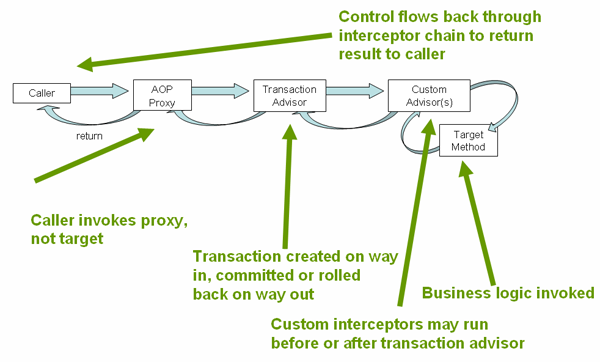스프링 프레임워크 데이터 액세스 공식 레퍼런스를 한글로 번역한 문서입니다.
버전은 5.3.2 기준입니다.
이번 레퍼런스 문서에선 데이터 접근과 관련된 이야기를 주로 다루며, 데이터 접근 레이어와 비즈니스(서비스) 레이어 간 상호 작용에 관해 설명한다.
스프링의 트랜잭션 관리 기능을 종합적으로 설명하며, 스프링 프레임워크와 통합되는 다양한 데이터 접근 프레임워크와 기술을 함께 다룬다.
목차:
- Transaction Management
- 1.1. Advantages of the Spring Framework’s Transaction Support Model
- 1.2. Understanding the Spring Framework Transaction Abstraction
- 1.3. Synchronizing Resources with Transactions
- 1.4. Declarative Transaction Management
- 1.4.1. Understanding the Spring Framework’s Declarative Transaction Implementation
- 1.4.2. Example of Declarative Transaction Implementation
- 1.4.3. Rolling Back a Declarative Transaction
- 1.4.4. Configuring Different Transactional Semantics for Different Beans
- 1.4.5. <tx:advice/> Settings
- 1.4.6. Using @Transactional
- 1.4.7. Transaction Propagation
- 1.4.8. Advising Transactional Operations
- 1.4.9. Using @Transactional with AspectJ
- 1.5. Programmatic Transaction Management
- 1.6. Choosing Between Programmatic and Declarative Transaction Management
- 1.7. Transaction-bound Events
- 1.8. Application server-specific integration
- 1.9. Solutions to Common Problems
- 1.10. Further Resources
- DAO Support
- Data Access with JDBC
- 3.1. Choosing an Approach for JDBC Database Access
- 3.2. Package Hierarchy
- 3.3. Using the JDBC Core Classes to Control Basic JDBC Processing and Error Handling
- 3.4. Controlling Database Connections
- 3.5. JDBC Batch Operations
- 3.6. Simplifying JDBC Operations with the SimpleJdbc Classes
- 3.6.1. Inserting Data by Using SimpleJdbcInsert
- 3.6.2. Retrieving Auto-generated Keys by Using SimpleJdbcInsert
- 3.6.3. Specifying Columns for a SimpleJdbcInsert
- 3.6.4. Using SqlParameterSource to Provide Parameter Values
- 3.6.5. Calling a Stored Procedure with SimpleJdbcCall
- 3.6.6. Explicitly Declaring Parameters to Use for a SimpleJdbcCall
- 3.6.7. How to Define SqlParameters
- 3.6.8. Calling a Stored Function by Using SimpleJdbcCall
- 3.6.9. Returning a ResultSet or REF Cursor from a SimpleJdbcCall
- 3.7. Modeling JDBC Operations as Java Objects
- 3.8. Common Problems with Parameter and Data Value Handling
- 3.9. Embedded Database Support
- 3.9.1. Why Use an Embedded Database?
- 3.9.2. Creating an Embedded Database by Using Spring XML
- 3.9.3. Creating an Embedded Database Programmatically
- 3.9.4. Selecting the Embedded Database Type
- 3.9.5. Testing Data Access Logic with an Embedded Database
- 3.9.6. Generating Unique Names for Embedded Databases
- 3.9.7. Extending the Embedded Database Support
- 3.10. Initializing a DataSource
- Data Access with R2DBC
- Retrieving Auto-generated Keys
- Object Relational Mapping (ORM) Data Access
- 6.1. Introduction to ORM with Spring
- 6.2. General ORM Integration Considerations
- 6.3. Hibernate
- 6.3.1. SessionFactory Setup in a Spring Container
- 6.3.2. Implementing DAOs Based on the Plain Hibernate API
- 6.3.3. Declarative Transaction Demarcation
- 6.3.4. Programmatic Transaction Demarcation
- 6.3.5. Transaction Management Strategies
- 6.3.6. Comparing Container-managed and Locally Defined Resources
- 6.3.7. Spurious Appl
- 6.4. JPA
- 6.4.1. Three Options for JPA Setup in a Spring Environment
- 6.4.2. Implementing DAOs Based on JPA: EntityManagerFactory and EntityManager
- 6.4.3. Spring-driven JPA transactions
- 6.4.4. Understanding JpaDialect and JpaVendorAdapter
- 6.4.5. Setting up JPA with JTA Transaction Management
- 6.4.6. Native Hibernate Setup and Native Hibernate Transactions for JPA Interaction
- Marshalling XML by Using Object-XML Mappers
- Appendix
Next : Transaction Management
Transaction Management
스프링 트랜잭션 관리 공식 문서를 한글로 번역한 문서입니다. 스프링의 트랜잭션 모델과 기술을 소개하고, 선언적인 방법과 프로그래밍 방식으로 트랜잭션을 관리하는 방법 설명합니다.